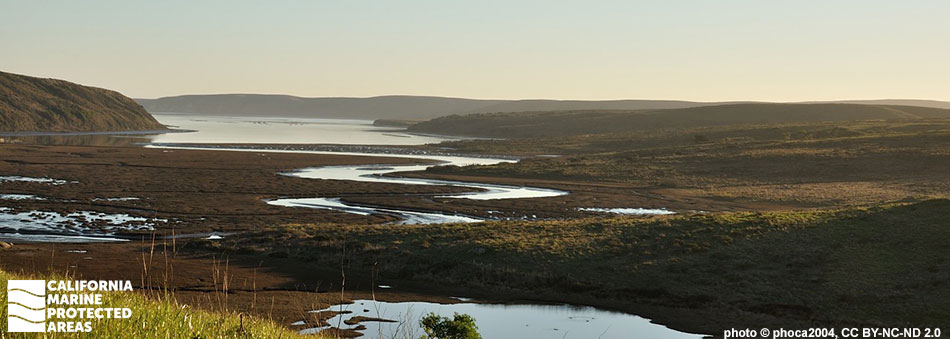
Overview
Estero de Limantour State Marine Reserve (SMR) and Drakes Estero State Marine Conservation Area (SMCA) are two neighboring estuarine marine protected areas (MPAs) located near Point Reyes. About 90 minutes from San Francisco in Marin County, Estero de Limantour SMR protects nearly 1½ square miles of sandy beaches, rocky shores, and estuarine habitat including tidal flats, coastal marsh, sandy seafloor, and eelgrass beds. Its neighbor, Point Reyes SMR, protects another approximately 9½ square miles of ocean waters, providing continuity between nearshore and estuarine habitats. Drakes Estero SMCA, to the north of Estero de Limantour SMR, covers 2½ miles of tidal mudflats, coastal marsh, sand/mud estuary bottom, and eelgrass beds.
The estuaries are also part of the Point Reyes National Seashore and Phillip Burton Wilderness. A popular destination for hikers, wildlife enthusiasts, bird watchers, and kayakers, Estero de Limantour SMR and Drakes Estero SMCA offer visitors an escape and the chance to see hundreds of species of birds, mammals, and fish. These MPAs serve as nurseries for Dungeness crab and various fish species, as well as harbor seal pupping areas and haul-out sites for marine mammals, and major foraging areas for leopard sharks, bat rays, and many bird species including black brant geese and brown pelicans.
Regulations
Estero de Limantour SMR
It is unlawful to injure, damage, take, or possess any living, geological, or cultural marine resource.
California Code of Regulations Title 14, Section 632(b)(46)(opens in new tab)
Drakes Estero SMCA
It is unlawful to injure, damage, take, or possess any living, geological, or cultural marine resource, EXCEPT:
Recreational take of clams is allowed.
California Code of Regulations Title 14, Section 632(b)(47)(opens in new tab)
Quick Facts
Estero de Limantour SMR
MPA size: 1.45 square miles
Shoreline span: 1.2 miles
Depth range: 0 to 10 feet
Habitat composition*:
- Estuary: 1.27 square miles
- Eelgrass: 0.22 square miles
- Coastal marsh: 1.61 square miles
Drakes Estero SMCA
MPA size: 2.50 square miles
Shoreline span: 0.6 miles
Depth range: 0 to 10 feet
Habitat composition*:
- Estuary: 2.40 square miles
- Eelgrass: 1.16 square miles
- Coastal marsh: 2.76 square miles
*Habitat calculations are based on three-dimensional area and may exceed the total MPA area listed above.